Strategic Management and Leadership Skills Report: Nestle Case
VerifiedAdded on 2022/10/01
|26
|6828
|47
Report
AI Summary
This report provides a detailed analysis of strategic management and leadership skills, using Nestle as a case study. It explores the link between strategic management and leadership, examining Nestle's strategic planning, leadership styles, and their impact on organizational strategy. The report delves into the impact of different management and leadership styles on strategic decisions, evaluates how leadership styles can be adapted to various situations, and reviews the influence of selected management and leadership theories on organizational strategy. Furthermore, the report addresses the assessment of leadership requirements, the creation of a leadership strategy to support organizational direction, and the planning of leadership skill development for future situations. The report also discusses methods for reviewing current leadership requirements and planning for the development of future leadership skills within the context of Nestle's operations and strategic goals. The analysis covers the impact of strategic management on leadership, the importance of innovation, and the adoption of different leadership styles to maintain the balance in operations.
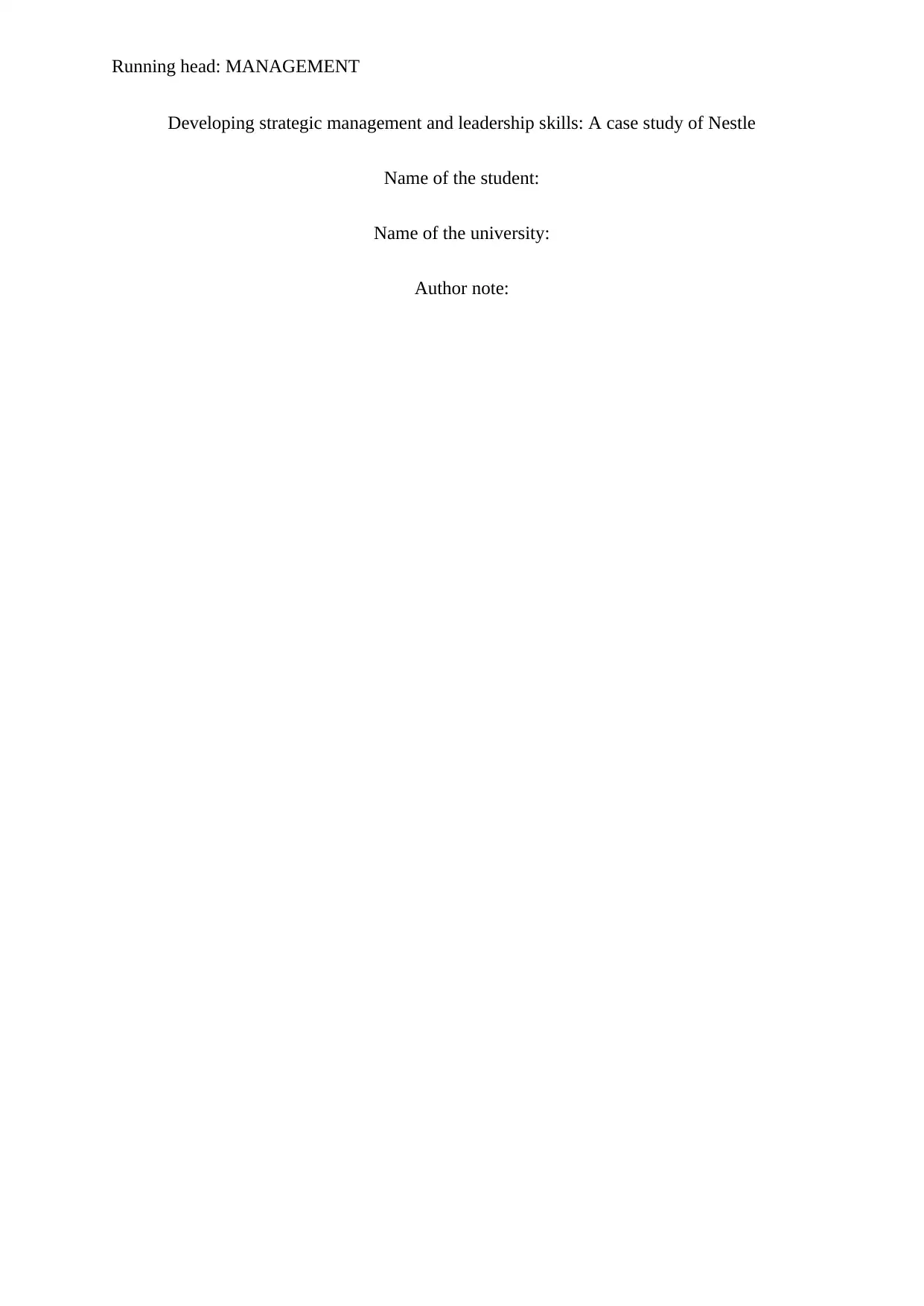
Running head: MANAGEMENT
Developing strategic management and leadership skills: A case study of Nestle
Name of the student:
Name of the university:
Author note:
Developing strategic management and leadership skills: A case study of Nestle
Name of the student:
Name of the university:
Author note:
Paraphrase This Document
Need a fresh take? Get an instant paraphrase of this document with our AI Paraphraser
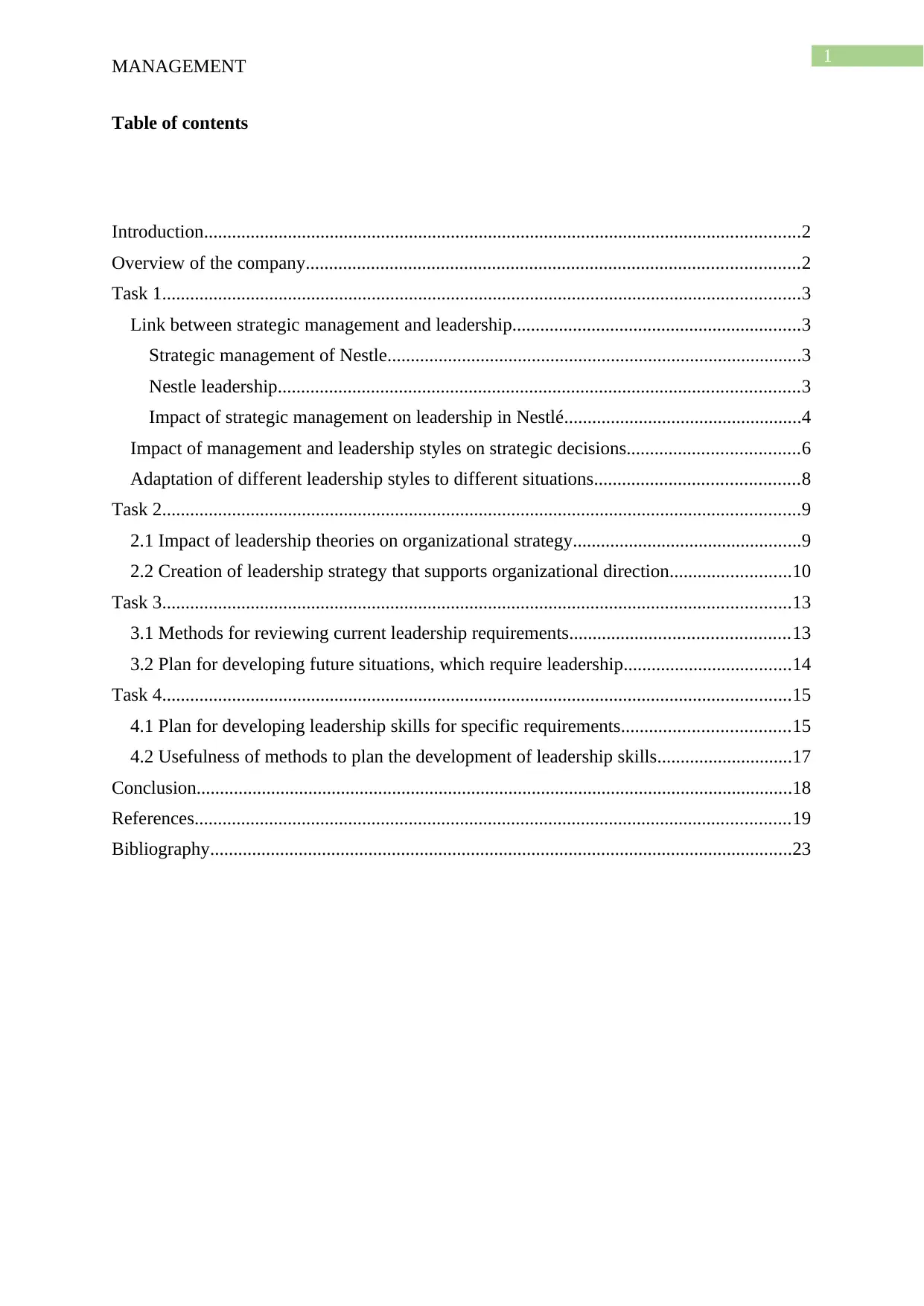
1
MANAGEMENT
Table of contents
Introduction................................................................................................................................2
Overview of the company..........................................................................................................2
Task 1.........................................................................................................................................3
Link between strategic management and leadership..............................................................3
Strategic management of Nestle.........................................................................................3
Nestle leadership................................................................................................................3
Impact of strategic management on leadership in Nestlé...................................................4
Impact of management and leadership styles on strategic decisions.....................................6
Adaptation of different leadership styles to different situations............................................8
Task 2.........................................................................................................................................9
2.1 Impact of leadership theories on organizational strategy.................................................9
2.2 Creation of leadership strategy that supports organizational direction..........................10
Task 3.......................................................................................................................................13
3.1 Methods for reviewing current leadership requirements...............................................13
3.2 Plan for developing future situations, which require leadership....................................14
Task 4.......................................................................................................................................15
4.1 Plan for developing leadership skills for specific requirements....................................15
4.2 Usefulness of methods to plan the development of leadership skills.............................17
Conclusion................................................................................................................................18
References................................................................................................................................19
Bibliography.............................................................................................................................23
MANAGEMENT
Table of contents
Introduction................................................................................................................................2
Overview of the company..........................................................................................................2
Task 1.........................................................................................................................................3
Link between strategic management and leadership..............................................................3
Strategic management of Nestle.........................................................................................3
Nestle leadership................................................................................................................3
Impact of strategic management on leadership in Nestlé...................................................4
Impact of management and leadership styles on strategic decisions.....................................6
Adaptation of different leadership styles to different situations............................................8
Task 2.........................................................................................................................................9
2.1 Impact of leadership theories on organizational strategy.................................................9
2.2 Creation of leadership strategy that supports organizational direction..........................10
Task 3.......................................................................................................................................13
3.1 Methods for reviewing current leadership requirements...............................................13
3.2 Plan for developing future situations, which require leadership....................................14
Task 4.......................................................................................................................................15
4.1 Plan for developing leadership skills for specific requirements....................................15
4.2 Usefulness of methods to plan the development of leadership skills.............................17
Conclusion................................................................................................................................18
References................................................................................................................................19
Bibliography.............................................................................................................................23
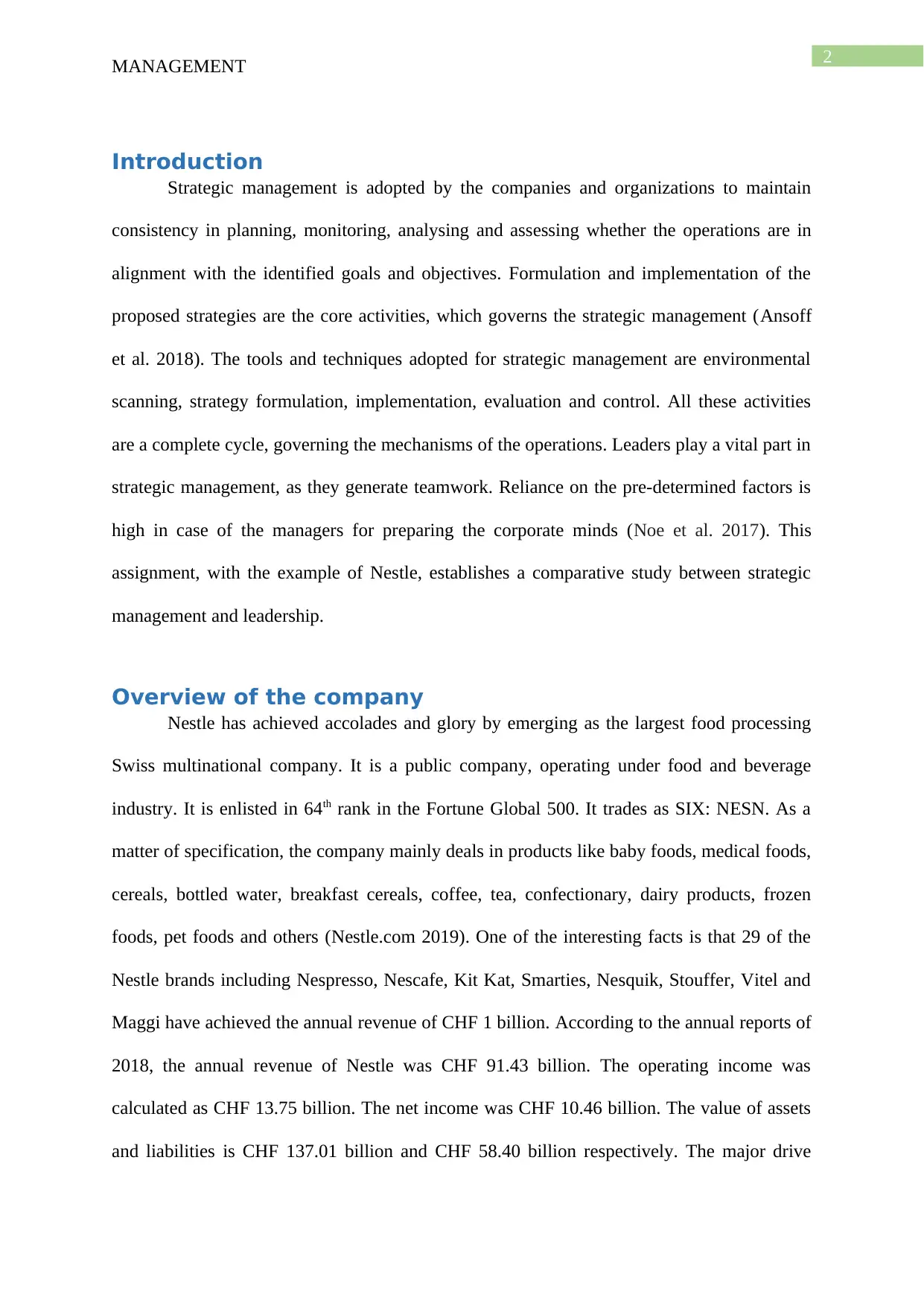
2
MANAGEMENT
Introduction
Strategic management is adopted by the companies and organizations to maintain
consistency in planning, monitoring, analysing and assessing whether the operations are in
alignment with the identified goals and objectives. Formulation and implementation of the
proposed strategies are the core activities, which governs the strategic management (Ansoff
et al. 2018). The tools and techniques adopted for strategic management are environmental
scanning, strategy formulation, implementation, evaluation and control. All these activities
are a complete cycle, governing the mechanisms of the operations. Leaders play a vital part in
strategic management, as they generate teamwork. Reliance on the pre-determined factors is
high in case of the managers for preparing the corporate minds (Noe et al. 2017). This
assignment, with the example of Nestle, establishes a comparative study between strategic
management and leadership.
Overview of the company
Nestle has achieved accolades and glory by emerging as the largest food processing
Swiss multinational company. It is a public company, operating under food and beverage
industry. It is enlisted in 64th rank in the Fortune Global 500. It trades as SIX: NESN. As a
matter of specification, the company mainly deals in products like baby foods, medical foods,
cereals, bottled water, breakfast cereals, coffee, tea, confectionary, dairy products, frozen
foods, pet foods and others (Nestle.com 2019). One of the interesting facts is that 29 of the
Nestle brands including Nespresso, Nescafe, Kit Kat, Smarties, Nesquik, Stouffer, Vitel and
Maggi have achieved the annual revenue of CHF 1 billion. According to the annual reports of
2018, the annual revenue of Nestle was CHF 91.43 billion. The operating income was
calculated as CHF 13.75 billion. The net income was CHF 10.46 billion. The value of assets
and liabilities is CHF 137.01 billion and CHF 58.40 billion respectively. The major drive
MANAGEMENT
Introduction
Strategic management is adopted by the companies and organizations to maintain
consistency in planning, monitoring, analysing and assessing whether the operations are in
alignment with the identified goals and objectives. Formulation and implementation of the
proposed strategies are the core activities, which governs the strategic management (Ansoff
et al. 2018). The tools and techniques adopted for strategic management are environmental
scanning, strategy formulation, implementation, evaluation and control. All these activities
are a complete cycle, governing the mechanisms of the operations. Leaders play a vital part in
strategic management, as they generate teamwork. Reliance on the pre-determined factors is
high in case of the managers for preparing the corporate minds (Noe et al. 2017). This
assignment, with the example of Nestle, establishes a comparative study between strategic
management and leadership.
Overview of the company
Nestle has achieved accolades and glory by emerging as the largest food processing
Swiss multinational company. It is a public company, operating under food and beverage
industry. It is enlisted in 64th rank in the Fortune Global 500. It trades as SIX: NESN. As a
matter of specification, the company mainly deals in products like baby foods, medical foods,
cereals, bottled water, breakfast cereals, coffee, tea, confectionary, dairy products, frozen
foods, pet foods and others (Nestle.com 2019). One of the interesting facts is that 29 of the
Nestle brands including Nespresso, Nescafe, Kit Kat, Smarties, Nesquik, Stouffer, Vitel and
Maggi have achieved the annual revenue of CHF 1 billion. According to the annual reports of
2018, the annual revenue of Nestle was CHF 91.43 billion. The operating income was
calculated as CHF 13.75 billion. The net income was CHF 10.46 billion. The value of assets
and liabilities is CHF 137.01 billion and CHF 58.40 billion respectively. The major drive
⊘ This is a preview!⊘
Do you want full access?
Subscribe today to unlock all pages.

Trusted by 1+ million students worldwide
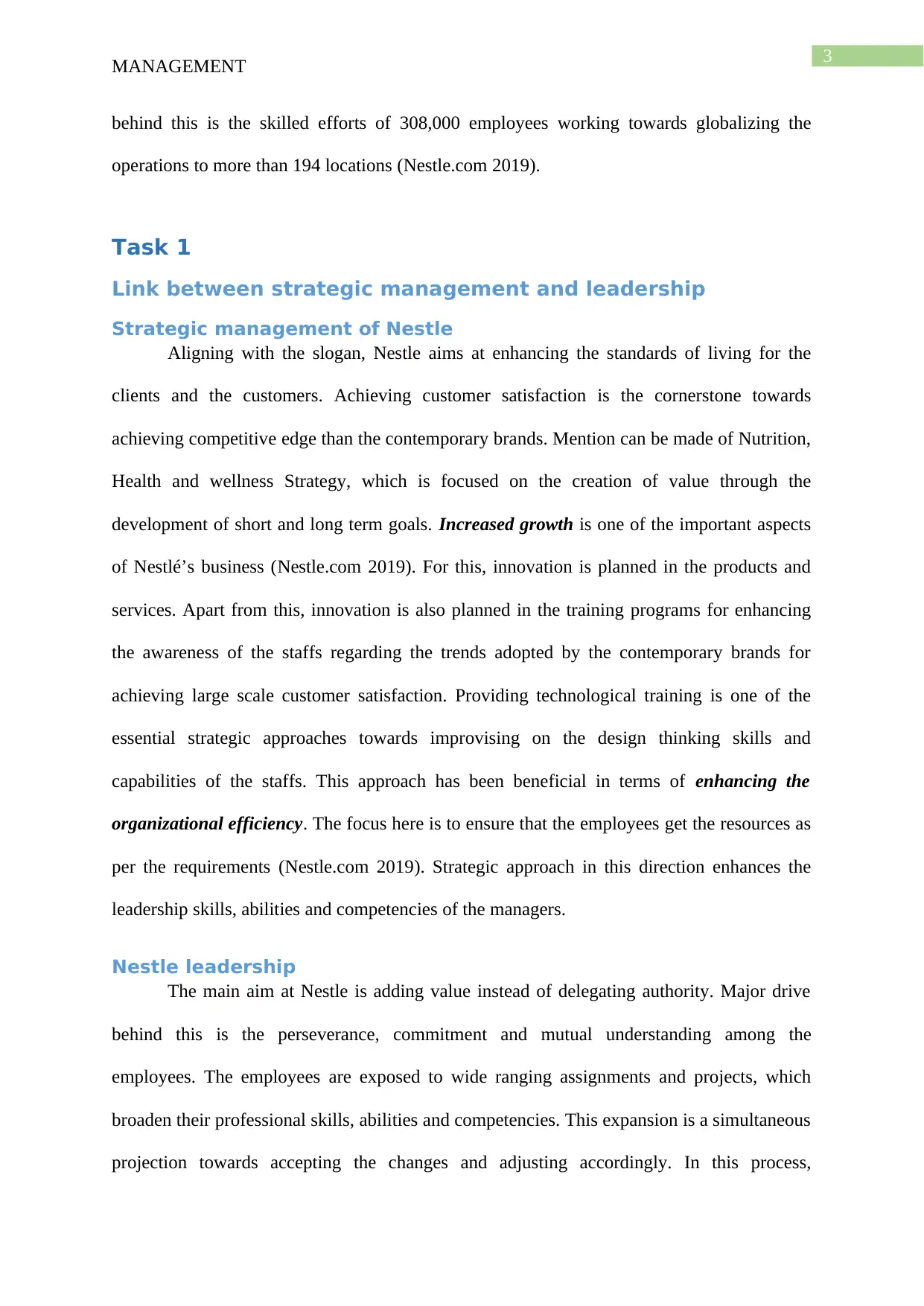
3
MANAGEMENT
behind this is the skilled efforts of 308,000 employees working towards globalizing the
operations to more than 194 locations (Nestle.com 2019).
Task 1
Link between strategic management and leadership
Strategic management of Nestle
Aligning with the slogan, Nestle aims at enhancing the standards of living for the
clients and the customers. Achieving customer satisfaction is the cornerstone towards
achieving competitive edge than the contemporary brands. Mention can be made of Nutrition,
Health and wellness Strategy, which is focused on the creation of value through the
development of short and long term goals. Increased growth is one of the important aspects
of Nestlé’s business (Nestle.com 2019). For this, innovation is planned in the products and
services. Apart from this, innovation is also planned in the training programs for enhancing
the awareness of the staffs regarding the trends adopted by the contemporary brands for
achieving large scale customer satisfaction. Providing technological training is one of the
essential strategic approaches towards improvising on the design thinking skills and
capabilities of the staffs. This approach has been beneficial in terms of enhancing the
organizational efficiency. The focus here is to ensure that the employees get the resources as
per the requirements (Nestle.com 2019). Strategic approach in this direction enhances the
leadership skills, abilities and competencies of the managers.
Nestle leadership
The main aim at Nestle is adding value instead of delegating authority. Major drive
behind this is the perseverance, commitment and mutual understanding among the
employees. The employees are exposed to wide ranging assignments and projects, which
broaden their professional skills, abilities and competencies. This expansion is a simultaneous
projection towards accepting the changes and adjusting accordingly. In this process,
MANAGEMENT
behind this is the skilled efforts of 308,000 employees working towards globalizing the
operations to more than 194 locations (Nestle.com 2019).
Task 1
Link between strategic management and leadership
Strategic management of Nestle
Aligning with the slogan, Nestle aims at enhancing the standards of living for the
clients and the customers. Achieving customer satisfaction is the cornerstone towards
achieving competitive edge than the contemporary brands. Mention can be made of Nutrition,
Health and wellness Strategy, which is focused on the creation of value through the
development of short and long term goals. Increased growth is one of the important aspects
of Nestlé’s business (Nestle.com 2019). For this, innovation is planned in the products and
services. Apart from this, innovation is also planned in the training programs for enhancing
the awareness of the staffs regarding the trends adopted by the contemporary brands for
achieving large scale customer satisfaction. Providing technological training is one of the
essential strategic approaches towards improvising on the design thinking skills and
capabilities of the staffs. This approach has been beneficial in terms of enhancing the
organizational efficiency. The focus here is to ensure that the employees get the resources as
per the requirements (Nestle.com 2019). Strategic approach in this direction enhances the
leadership skills, abilities and competencies of the managers.
Nestle leadership
The main aim at Nestle is adding value instead of delegating authority. Major drive
behind this is the perseverance, commitment and mutual understanding among the
employees. The employees are exposed to wide ranging assignments and projects, which
broaden their professional skills, abilities and competencies. This expansion is a simultaneous
projection towards accepting the changes and adjusting accordingly. In this process,
Paraphrase This Document
Need a fresh take? Get an instant paraphrase of this document with our AI Paraphraser
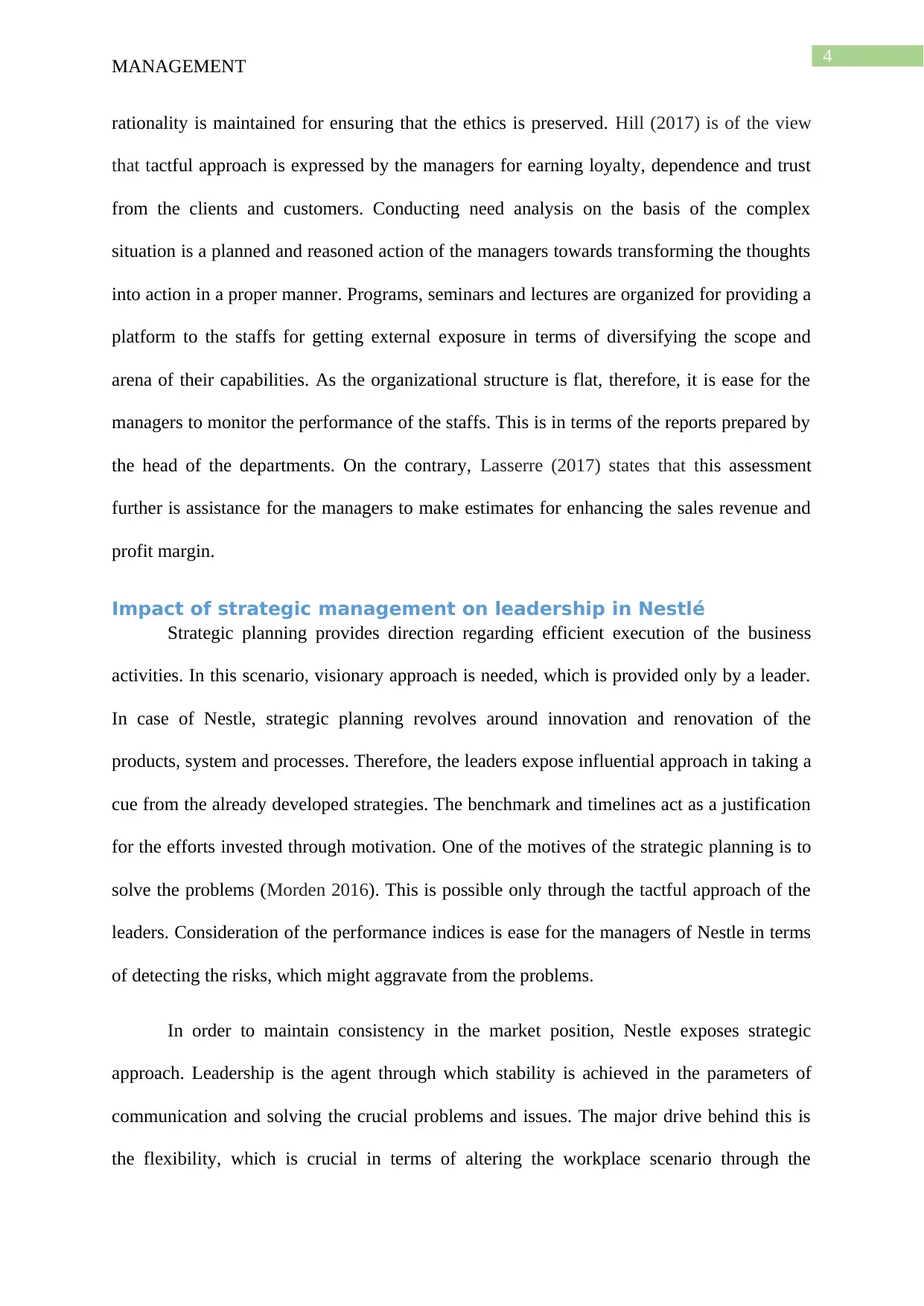
4
MANAGEMENT
rationality is maintained for ensuring that the ethics is preserved. Hill (2017) is of the view
that tactful approach is expressed by the managers for earning loyalty, dependence and trust
from the clients and customers. Conducting need analysis on the basis of the complex
situation is a planned and reasoned action of the managers towards transforming the thoughts
into action in a proper manner. Programs, seminars and lectures are organized for providing a
platform to the staffs for getting external exposure in terms of diversifying the scope and
arena of their capabilities. As the organizational structure is flat, therefore, it is ease for the
managers to monitor the performance of the staffs. This is in terms of the reports prepared by
the head of the departments. On the contrary, Lasserre (2017) states that this assessment
further is assistance for the managers to make estimates for enhancing the sales revenue and
profit margin.
Impact of strategic management on leadership in Nestlé
Strategic planning provides direction regarding efficient execution of the business
activities. In this scenario, visionary approach is needed, which is provided only by a leader.
In case of Nestle, strategic planning revolves around innovation and renovation of the
products, system and processes. Therefore, the leaders expose influential approach in taking a
cue from the already developed strategies. The benchmark and timelines act as a justification
for the efforts invested through motivation. One of the motives of the strategic planning is to
solve the problems (Morden 2016). This is possible only through the tactful approach of the
leaders. Consideration of the performance indices is ease for the managers of Nestle in terms
of detecting the risks, which might aggravate from the problems.
In order to maintain consistency in the market position, Nestle exposes strategic
approach. Leadership is the agent through which stability is achieved in the parameters of
communication and solving the crucial problems and issues. The major drive behind this is
the flexibility, which is crucial in terms of altering the workplace scenario through the
MANAGEMENT
rationality is maintained for ensuring that the ethics is preserved. Hill (2017) is of the view
that tactful approach is expressed by the managers for earning loyalty, dependence and trust
from the clients and customers. Conducting need analysis on the basis of the complex
situation is a planned and reasoned action of the managers towards transforming the thoughts
into action in a proper manner. Programs, seminars and lectures are organized for providing a
platform to the staffs for getting external exposure in terms of diversifying the scope and
arena of their capabilities. As the organizational structure is flat, therefore, it is ease for the
managers to monitor the performance of the staffs. This is in terms of the reports prepared by
the head of the departments. On the contrary, Lasserre (2017) states that this assessment
further is assistance for the managers to make estimates for enhancing the sales revenue and
profit margin.
Impact of strategic management on leadership in Nestlé
Strategic planning provides direction regarding efficient execution of the business
activities. In this scenario, visionary approach is needed, which is provided only by a leader.
In case of Nestle, strategic planning revolves around innovation and renovation of the
products, system and processes. Therefore, the leaders expose influential approach in taking a
cue from the already developed strategies. The benchmark and timelines act as a justification
for the efforts invested through motivation. One of the motives of the strategic planning is to
solve the problems (Morden 2016). This is possible only through the tactful approach of the
leaders. Consideration of the performance indices is ease for the managers of Nestle in terms
of detecting the risks, which might aggravate from the problems.
In order to maintain consistency in the market position, Nestle exposes strategic
approach. Leadership is the agent through which stability is achieved in the parameters of
communication and solving the crucial problems and issues. The major drive behind this is
the flexibility, which is crucial in terms of altering the workplace scenario through the
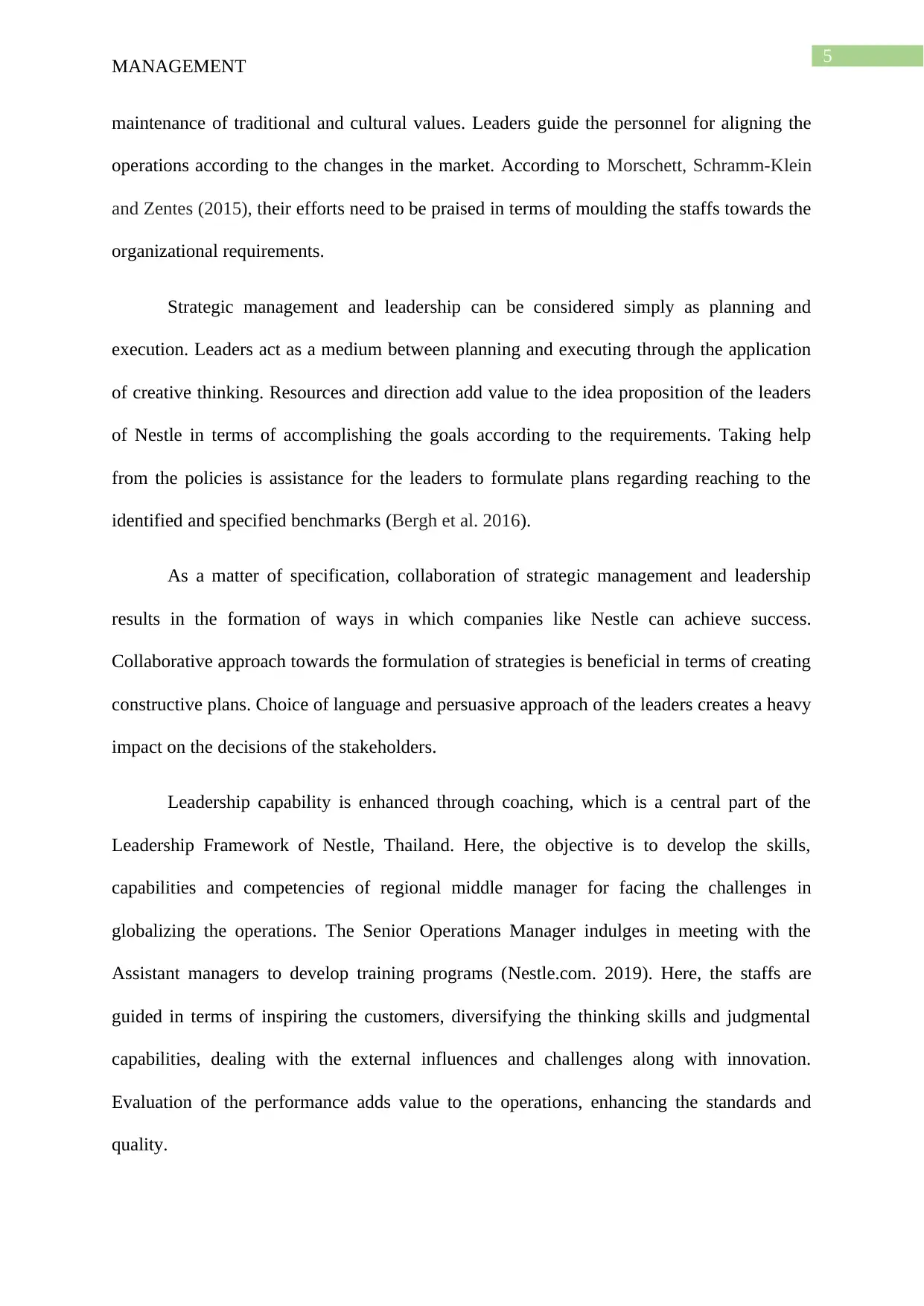
5
MANAGEMENT
maintenance of traditional and cultural values. Leaders guide the personnel for aligning the
operations according to the changes in the market. According to Morschett, Schramm-Klein
and Zentes (2015), their efforts need to be praised in terms of moulding the staffs towards the
organizational requirements.
Strategic management and leadership can be considered simply as planning and
execution. Leaders act as a medium between planning and executing through the application
of creative thinking. Resources and direction add value to the idea proposition of the leaders
of Nestle in terms of accomplishing the goals according to the requirements. Taking help
from the policies is assistance for the leaders to formulate plans regarding reaching to the
identified and specified benchmarks (Bergh et al. 2016).
As a matter of specification, collaboration of strategic management and leadership
results in the formation of ways in which companies like Nestle can achieve success.
Collaborative approach towards the formulation of strategies is beneficial in terms of creating
constructive plans. Choice of language and persuasive approach of the leaders creates a heavy
impact on the decisions of the stakeholders.
Leadership capability is enhanced through coaching, which is a central part of the
Leadership Framework of Nestle, Thailand. Here, the objective is to develop the skills,
capabilities and competencies of regional middle manager for facing the challenges in
globalizing the operations. The Senior Operations Manager indulges in meeting with the
Assistant managers to develop training programs (Nestle.com. 2019). Here, the staffs are
guided in terms of inspiring the customers, diversifying the thinking skills and judgmental
capabilities, dealing with the external influences and challenges along with innovation.
Evaluation of the performance adds value to the operations, enhancing the standards and
quality.
MANAGEMENT
maintenance of traditional and cultural values. Leaders guide the personnel for aligning the
operations according to the changes in the market. According to Morschett, Schramm-Klein
and Zentes (2015), their efforts need to be praised in terms of moulding the staffs towards the
organizational requirements.
Strategic management and leadership can be considered simply as planning and
execution. Leaders act as a medium between planning and executing through the application
of creative thinking. Resources and direction add value to the idea proposition of the leaders
of Nestle in terms of accomplishing the goals according to the requirements. Taking help
from the policies is assistance for the leaders to formulate plans regarding reaching to the
identified and specified benchmarks (Bergh et al. 2016).
As a matter of specification, collaboration of strategic management and leadership
results in the formation of ways in which companies like Nestle can achieve success.
Collaborative approach towards the formulation of strategies is beneficial in terms of creating
constructive plans. Choice of language and persuasive approach of the leaders creates a heavy
impact on the decisions of the stakeholders.
Leadership capability is enhanced through coaching, which is a central part of the
Leadership Framework of Nestle, Thailand. Here, the objective is to develop the skills,
capabilities and competencies of regional middle manager for facing the challenges in
globalizing the operations. The Senior Operations Manager indulges in meeting with the
Assistant managers to develop training programs (Nestle.com. 2019). Here, the staffs are
guided in terms of inspiring the customers, diversifying the thinking skills and judgmental
capabilities, dealing with the external influences and challenges along with innovation.
Evaluation of the performance adds value to the operations, enhancing the standards and
quality.
⊘ This is a preview!⊘
Do you want full access?
Subscribe today to unlock all pages.

Trusted by 1+ million students worldwide
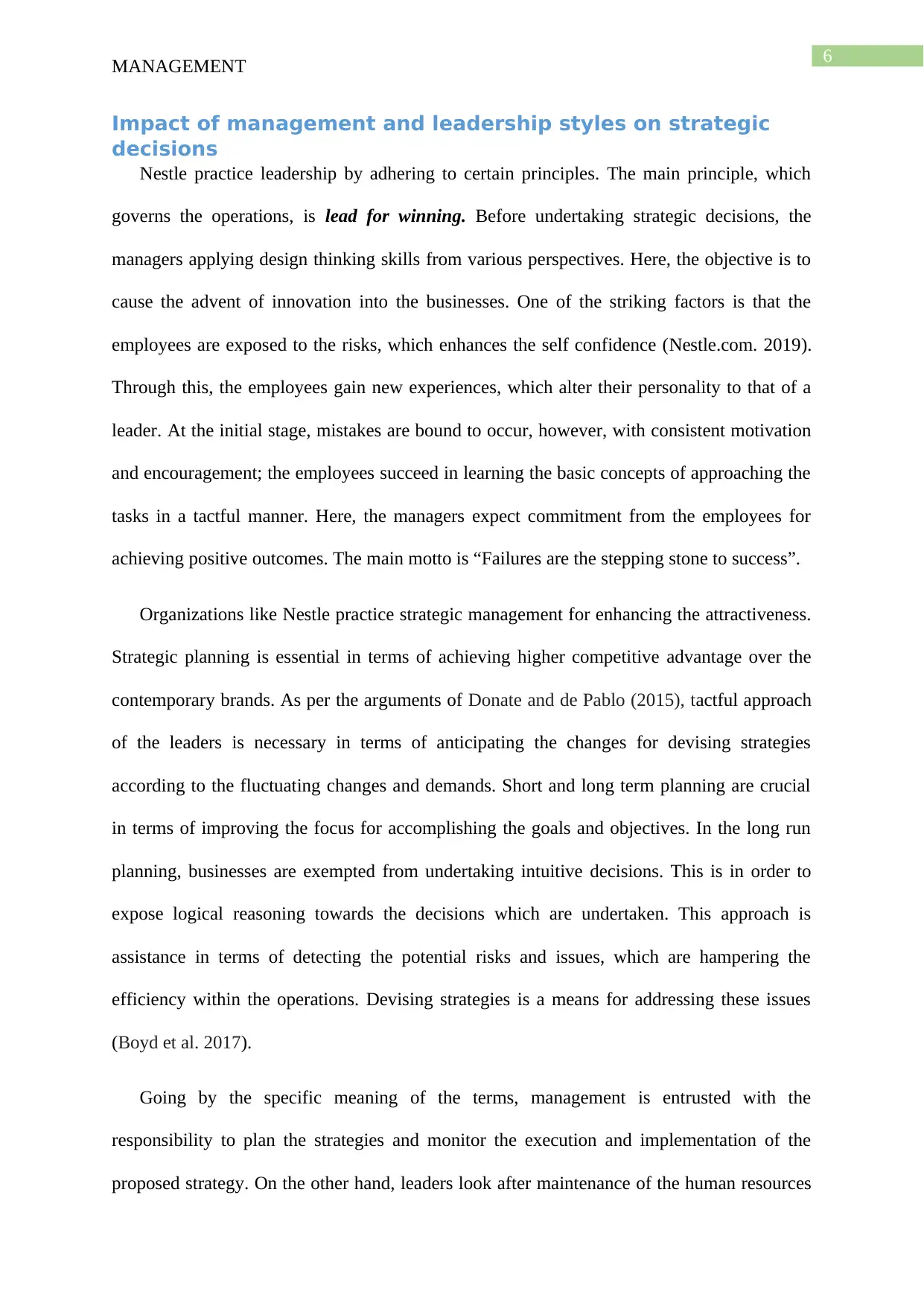
6
MANAGEMENT
Impact of management and leadership styles on strategic
decisions
Nestle practice leadership by adhering to certain principles. The main principle, which
governs the operations, is lead for winning. Before undertaking strategic decisions, the
managers applying design thinking skills from various perspectives. Here, the objective is to
cause the advent of innovation into the businesses. One of the striking factors is that the
employees are exposed to the risks, which enhances the self confidence (Nestle.com. 2019).
Through this, the employees gain new experiences, which alter their personality to that of a
leader. At the initial stage, mistakes are bound to occur, however, with consistent motivation
and encouragement; the employees succeed in learning the basic concepts of approaching the
tasks in a tactful manner. Here, the managers expect commitment from the employees for
achieving positive outcomes. The main motto is “Failures are the stepping stone to success”.
Organizations like Nestle practice strategic management for enhancing the attractiveness.
Strategic planning is essential in terms of achieving higher competitive advantage over the
contemporary brands. As per the arguments of Donate and de Pablo (2015), tactful approach
of the leaders is necessary in terms of anticipating the changes for devising strategies
according to the fluctuating changes and demands. Short and long term planning are crucial
in terms of improving the focus for accomplishing the goals and objectives. In the long run
planning, businesses are exempted from undertaking intuitive decisions. This is in order to
expose logical reasoning towards the decisions which are undertaken. This approach is
assistance in terms of detecting the potential risks and issues, which are hampering the
efficiency within the operations. Devising strategies is a means for addressing these issues
(Boyd et al. 2017).
Going by the specific meaning of the terms, management is entrusted with the
responsibility to plan the strategies and monitor the execution and implementation of the
proposed strategy. On the other hand, leaders look after maintenance of the human resources
MANAGEMENT
Impact of management and leadership styles on strategic
decisions
Nestle practice leadership by adhering to certain principles. The main principle, which
governs the operations, is lead for winning. Before undertaking strategic decisions, the
managers applying design thinking skills from various perspectives. Here, the objective is to
cause the advent of innovation into the businesses. One of the striking factors is that the
employees are exposed to the risks, which enhances the self confidence (Nestle.com. 2019).
Through this, the employees gain new experiences, which alter their personality to that of a
leader. At the initial stage, mistakes are bound to occur, however, with consistent motivation
and encouragement; the employees succeed in learning the basic concepts of approaching the
tasks in a tactful manner. Here, the managers expect commitment from the employees for
achieving positive outcomes. The main motto is “Failures are the stepping stone to success”.
Organizations like Nestle practice strategic management for enhancing the attractiveness.
Strategic planning is essential in terms of achieving higher competitive advantage over the
contemporary brands. As per the arguments of Donate and de Pablo (2015), tactful approach
of the leaders is necessary in terms of anticipating the changes for devising strategies
according to the fluctuating changes and demands. Short and long term planning are crucial
in terms of improving the focus for accomplishing the goals and objectives. In the long run
planning, businesses are exempted from undertaking intuitive decisions. This is in order to
expose logical reasoning towards the decisions which are undertaken. This approach is
assistance in terms of detecting the potential risks and issues, which are hampering the
efficiency within the operations. Devising strategies is a means for addressing these issues
(Boyd et al. 2017).
Going by the specific meaning of the terms, management is entrusted with the
responsibility to plan the strategies and monitor the execution and implementation of the
proposed strategy. On the other hand, leaders look after maintenance of the human resources
Paraphrase This Document
Need a fresh take? Get an instant paraphrase of this document with our AI Paraphraser
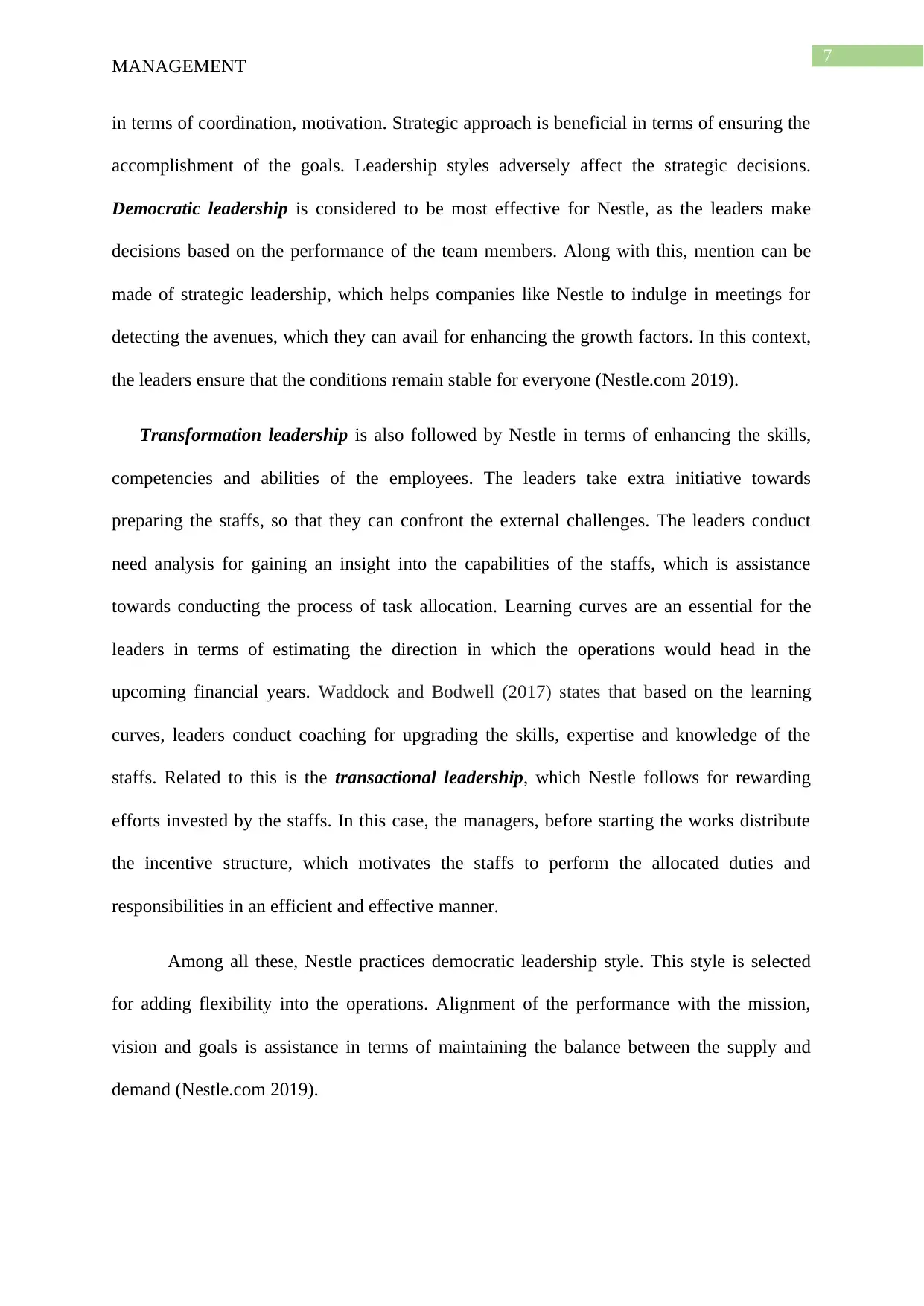
7
MANAGEMENT
in terms of coordination, motivation. Strategic approach is beneficial in terms of ensuring the
accomplishment of the goals. Leadership styles adversely affect the strategic decisions.
Democratic leadership is considered to be most effective for Nestle, as the leaders make
decisions based on the performance of the team members. Along with this, mention can be
made of strategic leadership, which helps companies like Nestle to indulge in meetings for
detecting the avenues, which they can avail for enhancing the growth factors. In this context,
the leaders ensure that the conditions remain stable for everyone (Nestle.com 2019).
Transformation leadership is also followed by Nestle in terms of enhancing the skills,
competencies and abilities of the employees. The leaders take extra initiative towards
preparing the staffs, so that they can confront the external challenges. The leaders conduct
need analysis for gaining an insight into the capabilities of the staffs, which is assistance
towards conducting the process of task allocation. Learning curves are an essential for the
leaders in terms of estimating the direction in which the operations would head in the
upcoming financial years. Waddock and Bodwell (2017) states that based on the learning
curves, leaders conduct coaching for upgrading the skills, expertise and knowledge of the
staffs. Related to this is the transactional leadership, which Nestle follows for rewarding
efforts invested by the staffs. In this case, the managers, before starting the works distribute
the incentive structure, which motivates the staffs to perform the allocated duties and
responsibilities in an efficient and effective manner.
Among all these, Nestle practices democratic leadership style. This style is selected
for adding flexibility into the operations. Alignment of the performance with the mission,
vision and goals is assistance in terms of maintaining the balance between the supply and
demand (Nestle.com 2019).
MANAGEMENT
in terms of coordination, motivation. Strategic approach is beneficial in terms of ensuring the
accomplishment of the goals. Leadership styles adversely affect the strategic decisions.
Democratic leadership is considered to be most effective for Nestle, as the leaders make
decisions based on the performance of the team members. Along with this, mention can be
made of strategic leadership, which helps companies like Nestle to indulge in meetings for
detecting the avenues, which they can avail for enhancing the growth factors. In this context,
the leaders ensure that the conditions remain stable for everyone (Nestle.com 2019).
Transformation leadership is also followed by Nestle in terms of enhancing the skills,
competencies and abilities of the employees. The leaders take extra initiative towards
preparing the staffs, so that they can confront the external challenges. The leaders conduct
need analysis for gaining an insight into the capabilities of the staffs, which is assistance
towards conducting the process of task allocation. Learning curves are an essential for the
leaders in terms of estimating the direction in which the operations would head in the
upcoming financial years. Waddock and Bodwell (2017) states that based on the learning
curves, leaders conduct coaching for upgrading the skills, expertise and knowledge of the
staffs. Related to this is the transactional leadership, which Nestle follows for rewarding
efforts invested by the staffs. In this case, the managers, before starting the works distribute
the incentive structure, which motivates the staffs to perform the allocated duties and
responsibilities in an efficient and effective manner.
Among all these, Nestle practices democratic leadership style. This style is selected
for adding flexibility into the operations. Alignment of the performance with the mission,
vision and goals is assistance in terms of maintaining the balance between the supply and
demand (Nestle.com 2019).
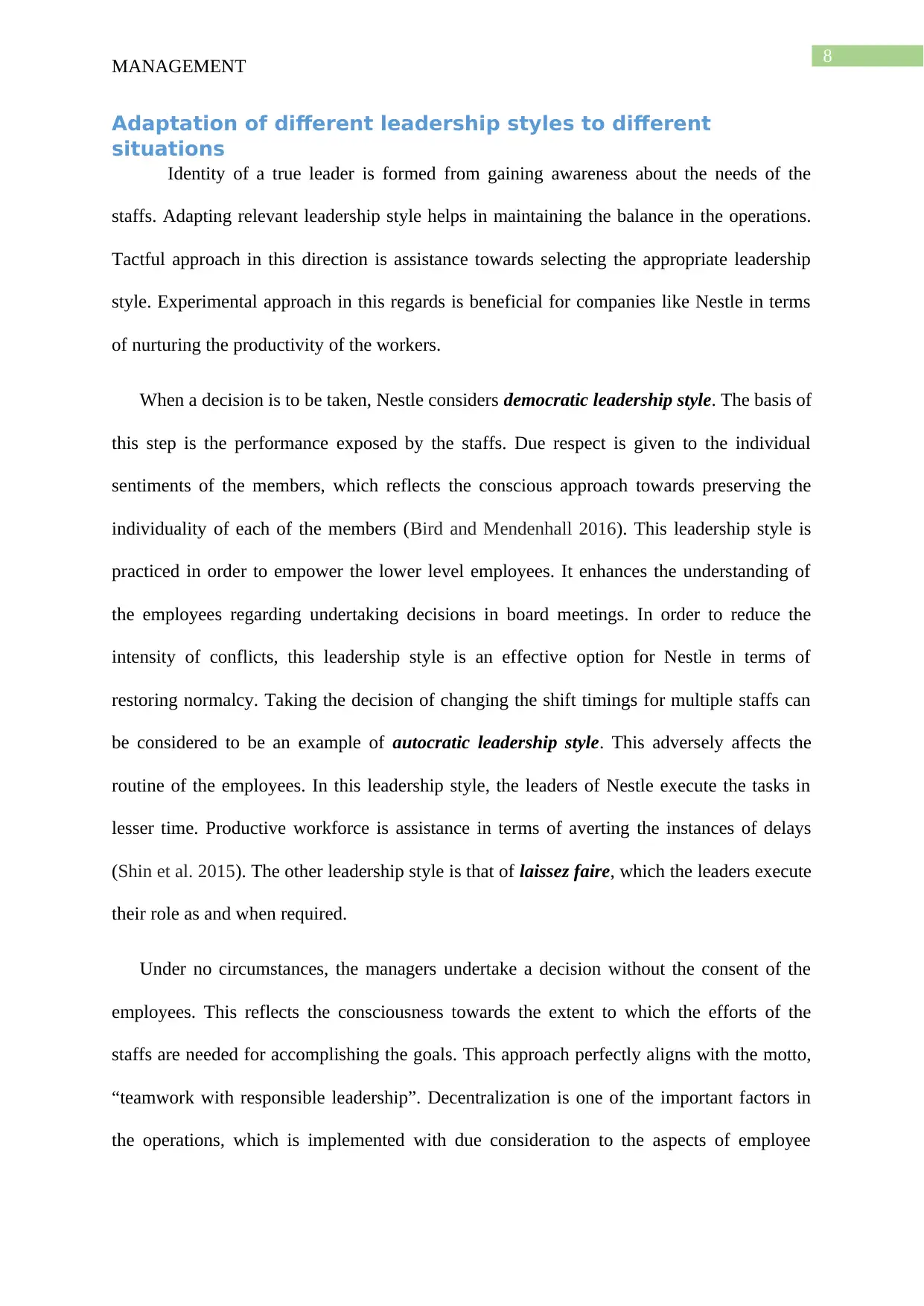
8
MANAGEMENT
Adaptation of different leadership styles to different
situations
Identity of a true leader is formed from gaining awareness about the needs of the
staffs. Adapting relevant leadership style helps in maintaining the balance in the operations.
Tactful approach in this direction is assistance towards selecting the appropriate leadership
style. Experimental approach in this regards is beneficial for companies like Nestle in terms
of nurturing the productivity of the workers.
When a decision is to be taken, Nestle considers democratic leadership style. The basis of
this step is the performance exposed by the staffs. Due respect is given to the individual
sentiments of the members, which reflects the conscious approach towards preserving the
individuality of each of the members (Bird and Mendenhall 2016). This leadership style is
practiced in order to empower the lower level employees. It enhances the understanding of
the employees regarding undertaking decisions in board meetings. In order to reduce the
intensity of conflicts, this leadership style is an effective option for Nestle in terms of
restoring normalcy. Taking the decision of changing the shift timings for multiple staffs can
be considered to be an example of autocratic leadership style. This adversely affects the
routine of the employees. In this leadership style, the leaders of Nestle execute the tasks in
lesser time. Productive workforce is assistance in terms of averting the instances of delays
(Shin et al. 2015). The other leadership style is that of laissez faire, which the leaders execute
their role as and when required.
Under no circumstances, the managers undertake a decision without the consent of the
employees. This reflects the consciousness towards the extent to which the efforts of the
staffs are needed for accomplishing the goals. This approach perfectly aligns with the motto,
“teamwork with responsible leadership”. Decentralization is one of the important factors in
the operations, which is implemented with due consideration to the aspects of employee
MANAGEMENT
Adaptation of different leadership styles to different
situations
Identity of a true leader is formed from gaining awareness about the needs of the
staffs. Adapting relevant leadership style helps in maintaining the balance in the operations.
Tactful approach in this direction is assistance towards selecting the appropriate leadership
style. Experimental approach in this regards is beneficial for companies like Nestle in terms
of nurturing the productivity of the workers.
When a decision is to be taken, Nestle considers democratic leadership style. The basis of
this step is the performance exposed by the staffs. Due respect is given to the individual
sentiments of the members, which reflects the conscious approach towards preserving the
individuality of each of the members (Bird and Mendenhall 2016). This leadership style is
practiced in order to empower the lower level employees. It enhances the understanding of
the employees regarding undertaking decisions in board meetings. In order to reduce the
intensity of conflicts, this leadership style is an effective option for Nestle in terms of
restoring normalcy. Taking the decision of changing the shift timings for multiple staffs can
be considered to be an example of autocratic leadership style. This adversely affects the
routine of the employees. In this leadership style, the leaders of Nestle execute the tasks in
lesser time. Productive workforce is assistance in terms of averting the instances of delays
(Shin et al. 2015). The other leadership style is that of laissez faire, which the leaders execute
their role as and when required.
Under no circumstances, the managers undertake a decision without the consent of the
employees. This reflects the consciousness towards the extent to which the efforts of the
staffs are needed for accomplishing the goals. This approach perfectly aligns with the motto,
“teamwork with responsible leadership”. Decentralization is one of the important factors in
the operations, which is implemented with due consideration to the aspects of employee
⊘ This is a preview!⊘
Do you want full access?
Subscribe today to unlock all pages.

Trusted by 1+ million students worldwide
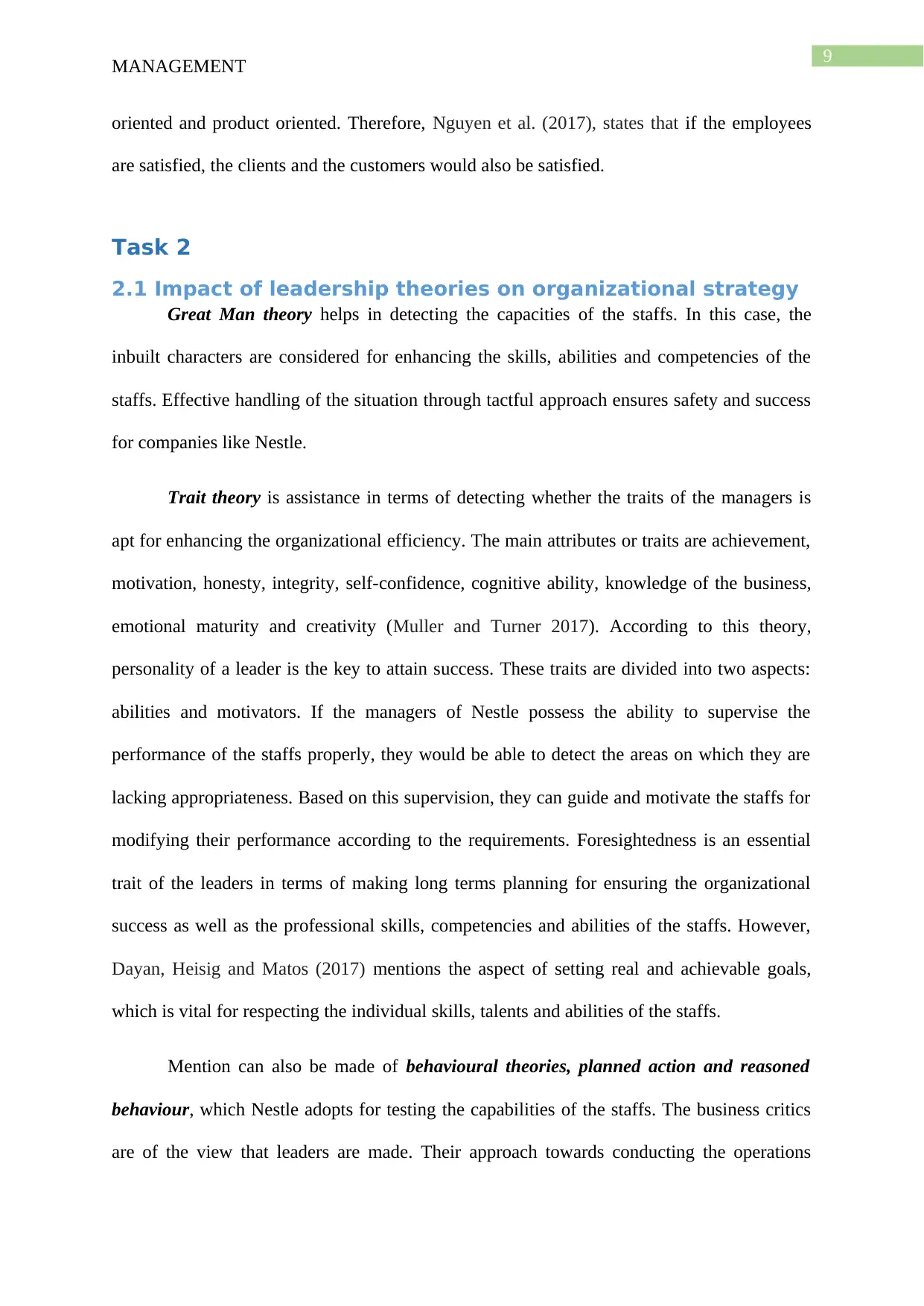
9
MANAGEMENT
oriented and product oriented. Therefore, Nguyen et al. (2017), states that if the employees
are satisfied, the clients and the customers would also be satisfied.
Task 2
2.1 Impact of leadership theories on organizational strategy
Great Man theory helps in detecting the capacities of the staffs. In this case, the
inbuilt characters are considered for enhancing the skills, abilities and competencies of the
staffs. Effective handling of the situation through tactful approach ensures safety and success
for companies like Nestle.
Trait theory is assistance in terms of detecting whether the traits of the managers is
apt for enhancing the organizational efficiency. The main attributes or traits are achievement,
motivation, honesty, integrity, self-confidence, cognitive ability, knowledge of the business,
emotional maturity and creativity (Muller and Turner 2017). According to this theory,
personality of a leader is the key to attain success. These traits are divided into two aspects:
abilities and motivators. If the managers of Nestle possess the ability to supervise the
performance of the staffs properly, they would be able to detect the areas on which they are
lacking appropriateness. Based on this supervision, they can guide and motivate the staffs for
modifying their performance according to the requirements. Foresightedness is an essential
trait of the leaders in terms of making long terms planning for ensuring the organizational
success as well as the professional skills, competencies and abilities of the staffs. However,
Dayan, Heisig and Matos (2017) mentions the aspect of setting real and achievable goals,
which is vital for respecting the individual skills, talents and abilities of the staffs.
Mention can also be made of behavioural theories, planned action and reasoned
behaviour, which Nestle adopts for testing the capabilities of the staffs. The business critics
are of the view that leaders are made. Their approach towards conducting the operations
MANAGEMENT
oriented and product oriented. Therefore, Nguyen et al. (2017), states that if the employees
are satisfied, the clients and the customers would also be satisfied.
Task 2
2.1 Impact of leadership theories on organizational strategy
Great Man theory helps in detecting the capacities of the staffs. In this case, the
inbuilt characters are considered for enhancing the skills, abilities and competencies of the
staffs. Effective handling of the situation through tactful approach ensures safety and success
for companies like Nestle.
Trait theory is assistance in terms of detecting whether the traits of the managers is
apt for enhancing the organizational efficiency. The main attributes or traits are achievement,
motivation, honesty, integrity, self-confidence, cognitive ability, knowledge of the business,
emotional maturity and creativity (Muller and Turner 2017). According to this theory,
personality of a leader is the key to attain success. These traits are divided into two aspects:
abilities and motivators. If the managers of Nestle possess the ability to supervise the
performance of the staffs properly, they would be able to detect the areas on which they are
lacking appropriateness. Based on this supervision, they can guide and motivate the staffs for
modifying their performance according to the requirements. Foresightedness is an essential
trait of the leaders in terms of making long terms planning for ensuring the organizational
success as well as the professional skills, competencies and abilities of the staffs. However,
Dayan, Heisig and Matos (2017) mentions the aspect of setting real and achievable goals,
which is vital for respecting the individual skills, talents and abilities of the staffs.
Mention can also be made of behavioural theories, planned action and reasoned
behaviour, which Nestle adopts for testing the capabilities of the staffs. The business critics
are of the view that leaders are made. Their approach towards conducting the operations
Paraphrase This Document
Need a fresh take? Get an instant paraphrase of this document with our AI Paraphraser
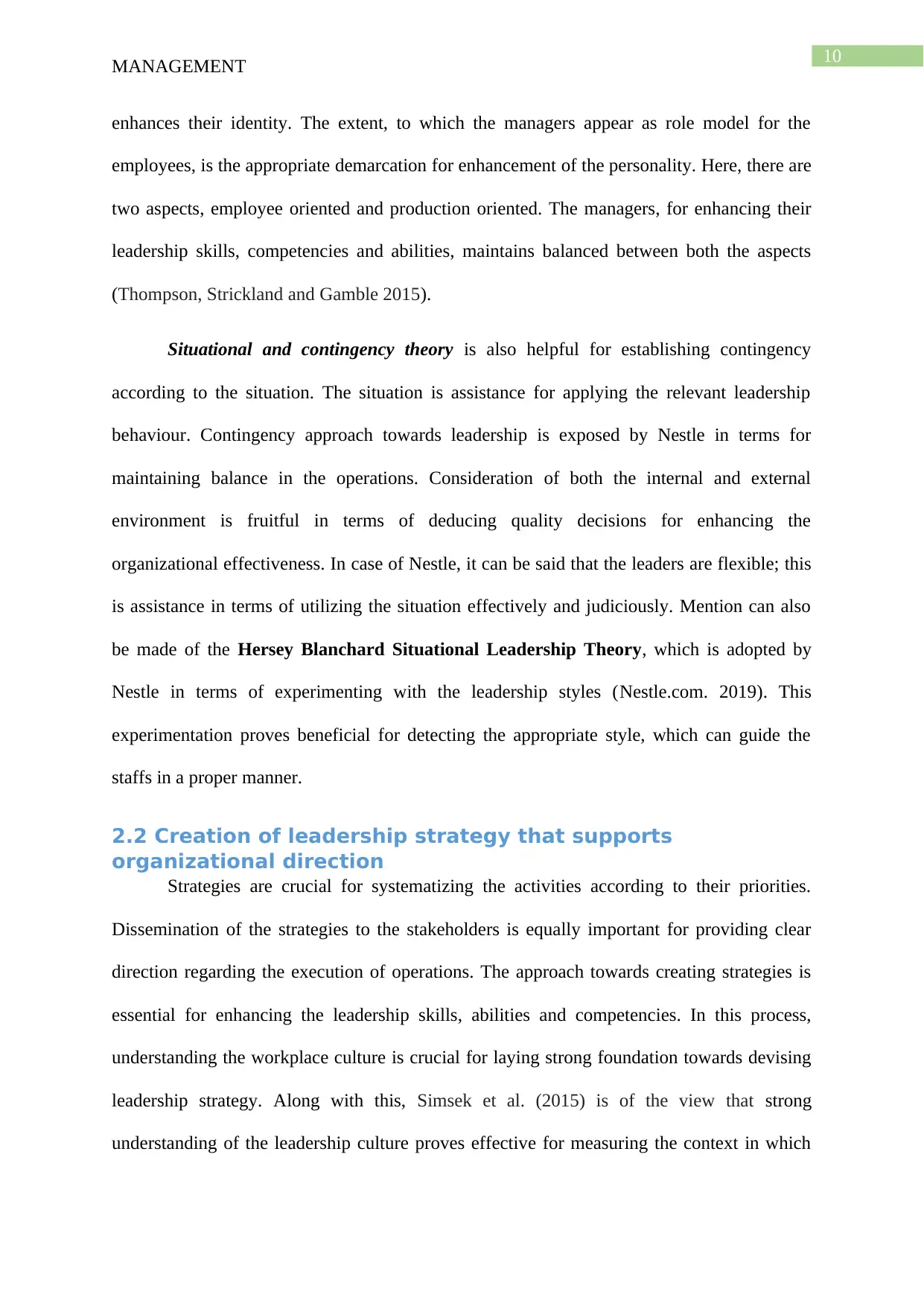
10
MANAGEMENT
enhances their identity. The extent, to which the managers appear as role model for the
employees, is the appropriate demarcation for enhancement of the personality. Here, there are
two aspects, employee oriented and production oriented. The managers, for enhancing their
leadership skills, competencies and abilities, maintains balanced between both the aspects
(Thompson, Strickland and Gamble 2015).
Situational and contingency theory is also helpful for establishing contingency
according to the situation. The situation is assistance for applying the relevant leadership
behaviour. Contingency approach towards leadership is exposed by Nestle in terms for
maintaining balance in the operations. Consideration of both the internal and external
environment is fruitful in terms of deducing quality decisions for enhancing the
organizational effectiveness. In case of Nestle, it can be said that the leaders are flexible; this
is assistance in terms of utilizing the situation effectively and judiciously. Mention can also
be made of the Hersey Blanchard Situational Leadership Theory, which is adopted by
Nestle in terms of experimenting with the leadership styles (Nestle.com. 2019). This
experimentation proves beneficial for detecting the appropriate style, which can guide the
staffs in a proper manner.
2.2 Creation of leadership strategy that supports
organizational direction
Strategies are crucial for systematizing the activities according to their priorities.
Dissemination of the strategies to the stakeholders is equally important for providing clear
direction regarding the execution of operations. The approach towards creating strategies is
essential for enhancing the leadership skills, abilities and competencies. In this process,
understanding the workplace culture is crucial for laying strong foundation towards devising
leadership strategy. Along with this, Simsek et al. (2015) is of the view that strong
understanding of the leadership culture proves effective for measuring the context in which
MANAGEMENT
enhances their identity. The extent, to which the managers appear as role model for the
employees, is the appropriate demarcation for enhancement of the personality. Here, there are
two aspects, employee oriented and production oriented. The managers, for enhancing their
leadership skills, competencies and abilities, maintains balanced between both the aspects
(Thompson, Strickland and Gamble 2015).
Situational and contingency theory is also helpful for establishing contingency
according to the situation. The situation is assistance for applying the relevant leadership
behaviour. Contingency approach towards leadership is exposed by Nestle in terms for
maintaining balance in the operations. Consideration of both the internal and external
environment is fruitful in terms of deducing quality decisions for enhancing the
organizational effectiveness. In case of Nestle, it can be said that the leaders are flexible; this
is assistance in terms of utilizing the situation effectively and judiciously. Mention can also
be made of the Hersey Blanchard Situational Leadership Theory, which is adopted by
Nestle in terms of experimenting with the leadership styles (Nestle.com. 2019). This
experimentation proves beneficial for detecting the appropriate style, which can guide the
staffs in a proper manner.
2.2 Creation of leadership strategy that supports
organizational direction
Strategies are crucial for systematizing the activities according to their priorities.
Dissemination of the strategies to the stakeholders is equally important for providing clear
direction regarding the execution of operations. The approach towards creating strategies is
essential for enhancing the leadership skills, abilities and competencies. In this process,
understanding the workplace culture is crucial for laying strong foundation towards devising
leadership strategy. Along with this, Simsek et al. (2015) is of the view that strong
understanding of the leadership culture proves effective for measuring the context in which
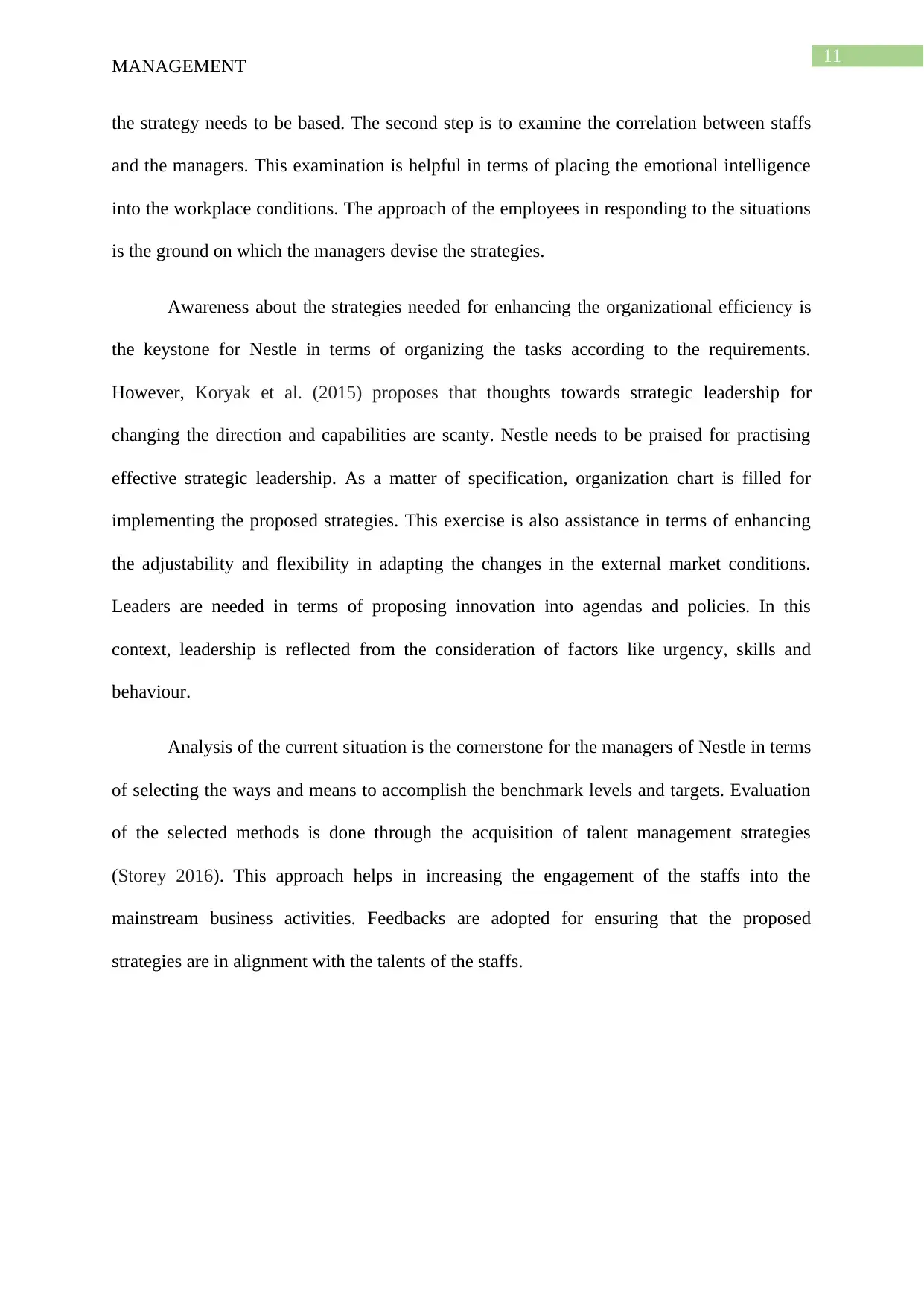
11
MANAGEMENT
the strategy needs to be based. The second step is to examine the correlation between staffs
and the managers. This examination is helpful in terms of placing the emotional intelligence
into the workplace conditions. The approach of the employees in responding to the situations
is the ground on which the managers devise the strategies.
Awareness about the strategies needed for enhancing the organizational efficiency is
the keystone for Nestle in terms of organizing the tasks according to the requirements.
However, Koryak et al. (2015) proposes that thoughts towards strategic leadership for
changing the direction and capabilities are scanty. Nestle needs to be praised for practising
effective strategic leadership. As a matter of specification, organization chart is filled for
implementing the proposed strategies. This exercise is also assistance in terms of enhancing
the adjustability and flexibility in adapting the changes in the external market conditions.
Leaders are needed in terms of proposing innovation into agendas and policies. In this
context, leadership is reflected from the consideration of factors like urgency, skills and
behaviour.
Analysis of the current situation is the cornerstone for the managers of Nestle in terms
of selecting the ways and means to accomplish the benchmark levels and targets. Evaluation
of the selected methods is done through the acquisition of talent management strategies
(Storey 2016). This approach helps in increasing the engagement of the staffs into the
mainstream business activities. Feedbacks are adopted for ensuring that the proposed
strategies are in alignment with the talents of the staffs.
MANAGEMENT
the strategy needs to be based. The second step is to examine the correlation between staffs
and the managers. This examination is helpful in terms of placing the emotional intelligence
into the workplace conditions. The approach of the employees in responding to the situations
is the ground on which the managers devise the strategies.
Awareness about the strategies needed for enhancing the organizational efficiency is
the keystone for Nestle in terms of organizing the tasks according to the requirements.
However, Koryak et al. (2015) proposes that thoughts towards strategic leadership for
changing the direction and capabilities are scanty. Nestle needs to be praised for practising
effective strategic leadership. As a matter of specification, organization chart is filled for
implementing the proposed strategies. This exercise is also assistance in terms of enhancing
the adjustability and flexibility in adapting the changes in the external market conditions.
Leaders are needed in terms of proposing innovation into agendas and policies. In this
context, leadership is reflected from the consideration of factors like urgency, skills and
behaviour.
Analysis of the current situation is the cornerstone for the managers of Nestle in terms
of selecting the ways and means to accomplish the benchmark levels and targets. Evaluation
of the selected methods is done through the acquisition of talent management strategies
(Storey 2016). This approach helps in increasing the engagement of the staffs into the
mainstream business activities. Feedbacks are adopted for ensuring that the proposed
strategies are in alignment with the talents of the staffs.
⊘ This is a preview!⊘
Do you want full access?
Subscribe today to unlock all pages.

Trusted by 1+ million students worldwide
1 out of 26
Related Documents
Your All-in-One AI-Powered Toolkit for Academic Success.
+13062052269
info@desklib.com
Available 24*7 on WhatsApp / Email
![[object Object]](/_next/static/media/star-bottom.7253800d.svg)
Unlock your academic potential
Copyright © 2020–2025 A2Z Services. All Rights Reserved. Developed and managed by ZUCOL.





